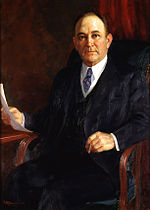United States Senate elections, 1936
|
|
|||||||||||||||||||||||||||||||||||||||||||||||||||||
|---|---|---|---|---|---|---|---|---|---|---|---|---|---|---|---|---|---|---|---|---|---|---|---|---|---|---|---|---|---|---|---|---|---|---|---|---|---|---|---|---|---|---|---|---|---|---|---|---|---|---|---|---|---|
|
|||||||||||||||||||||||||||||||||||||||||||||||||||||
|
36 of the 96 seats in the United States Senate 49 seats were needed for a majority |
|||||||||||||||||||||||||||||||||||||||||||||||||||||
|
|||||||||||||||||||||||||||||||||||||||||||||||||||||

Republican hold
Republican gain
Democratic hold
Democratic gain
Farmer-Labor hold
Independent gain
|
|||||||||||||||||||||||||||||||||||||||||||||||||||||
|
|||||||||||||||||||||||||||||||||||||||||||||||||||||
The United States Senate elections of 1936 coincided with the re-election of Franklin Delano Roosevelt. The Great Depression continued, and voters backed progressive candidates favoring Roosevelt's New Deal in races across the country. The Democrats gained 6 net seats during the election, and in combination with Democratic and Farmer-Labor interim appointments and the defection of George W. Norris from the Republican Party to become independent, the Republicans were reduced to 16 seats, the most lopsided Senate since Reconstruction. This was the last of four consecutive elections where Republicans suffered losses due to the ongoing effects of the Great Depression. This was also the last Senate election in the 20th century in which a Democratic candidate who won two terms also made net gains in the Senate on both occasions (although Franklin Roosevelt won a third and fourth term, he lost Senate seats on both occasions).
The Republicans took one open seat in Massachusetts, while the Democrats took open seats in Michigan and New Hampshire and defeated incumbents Daniel O. Hastings (R-DE), Lester J. Dickinson (R-IA), W. Warren Barbour (R-NJ), Jesse H. Metcalf (R-RI), and Robert D. Carey (R-WY).
...
Wikipedia


